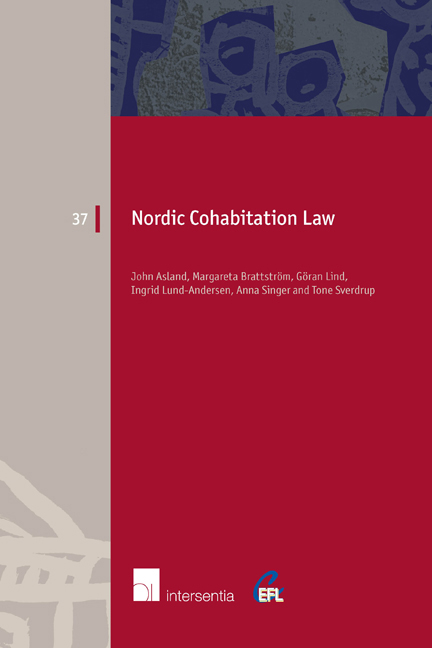Book contents
- Frontmatter
- Preface
- Contents
- Table of Cases
- List of Abbreviations
- Chapter 1 The Development of Cohabitation and Cohabitation Law in the Nordic Countries
- Chapter 2 Property Issues in Cohabitation Relationships
- Chapter 3 Financial Settlements on Termination of Cohabitation
- Chapter 4 The Legal Position of the Surviving Cohabitant
- Chapter 5 The Relevance of Cohabitation for Parental Rights
- Chapter 6 The Distinctive Legal Nature of Cohabitation Relationships and the Need for Legislation
- Chapter 7 Discussion of Legal Policy: Principles for Regulating Cohabitation Relationships
- References
- About the Authors
- European Family Law Series
Chapter 1 - The Development of Cohabitation and Cohabitation Law in the Nordic Countries
Published online by Cambridge University Press: 13 December 2017
- Frontmatter
- Preface
- Contents
- Table of Cases
- List of Abbreviations
- Chapter 1 The Development of Cohabitation and Cohabitation Law in the Nordic Countries
- Chapter 2 Property Issues in Cohabitation Relationships
- Chapter 3 Financial Settlements on Termination of Cohabitation
- Chapter 4 The Legal Position of the Surviving Cohabitant
- Chapter 5 The Relevance of Cohabitation for Parental Rights
- Chapter 6 The Distinctive Legal Nature of Cohabitation Relationships and the Need for Legislation
- Chapter 7 Discussion of Legal Policy: Principles for Regulating Cohabitation Relationships
- References
- About the Authors
- European Family Law Series
Summary
INTRODUCTION
Historic background: Cohabitation has a long history in Nordic law. While the historic evolution of cohabitation is not the subject of this book, it is interesting to note that, prior to the legal requirement introduced in the Nordic countries in the 17th and 18th centuries for marriages to be conducted in church, informal relationships were recognised as marriage. This had its basis in the canon law of the Catholic Church, which in turn was inspired by the free marriage that was a feature of Roman law. Since formal marriage ceremonies became compulsory in order to legally contract a marriage, there have always been couples who for various reasons have not wished or have been unable to marry and have therefore cohabited outside marriage. More than a hundred years ago, for example, in Sweden and Finland informal cohabitation was used by women instead of marriage to avoid being subjected to their partner's authority (målsmanskap) over her – a married woman was legally a minor – and even up to the present day same-sex couples have been barred from marriage and have therefore cohabited.
The development of modern cohabitation, which will be discussed in this chapter, has its origin in the late 1960s when the number of marriages fell sharply while at the same time the number of cohabitation relationships and the number of children born outside marriage – now generally referred to as children born to single mothers – rose dramatically. It became more generally acceptable for couples to live together and to start a family without being married. Attitudes to same-sex relationships also changed and they became more widely accepted.
These trends presented Nordic courts and legislators with some serious challenges and sparked much discussion concerning both the question of which rules of law were actually applicable to cohabitation relationships and whether there was a need to introduce special legislation governing such relationships (and if so, how it should be framed).
Nordic cooperation: Unlike the fruitful Nordic cooperation that took place in the early 20th century in the area of family law and that gave rise to a large body of compatible legislation, in the past forty years Nordic legislators have, despite the existence of fairly similar general societal conditions and attitudes across their countries, sought in very different ways to meet the challenges that unmarried cohabitation presents.
- Type
- Chapter
- Information
- Nordic Cohabitation Law , pp. 1 - 56Publisher: IntersentiaPrint publication year: 2015



